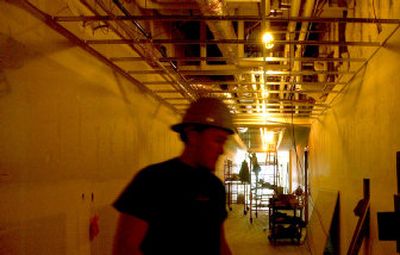New hospital fills treatment gap

A new hospital opening soon in Post Falls will fill a medical gap in the Inland Northwest, health care professionals say.
The $15 million Northern Idaho Advanced Care Hospital is under construction near Wal-Mart in Post Falls and is expected to be open in February.
The long-term acute care hospital will hire 100 full-time employees, including doctors, who will care for 40 patients too medically fragile to go to a rehabilitation facility or a nursing home.
The Inland Northwest has no long-term acute care hospital, where the average stay is at least 25 days, although area hospitals recognize the need for one. Those who have needed such care have been sent to long-term care facilities in Seattle or Denver, or are kept in acute care hospitals like Kootenai Medical Center or Deaconess Medical Center, or are sent to nursing homes.
“We look at this as part of a continuum of care,” said Rick Richards, CEO of the new hospital owned by Ernest Health Care, a relatively new company that has opened similar hospitals in Las Cruces, N.M., Brownsville, Texas, and Greeley, Colo.
“We will have an intense level of care,” he said. Multiple trauma patients, people in comas and with brain injuries, patients on ventilators, stroke patients and others with severe medical problems will be served in the 36,000 square-foot hospital.
“We will be able to take them to that next level, which could be rehabilitation or home,” said Chad Hutson, hospital marketing director.
Originally, Ernest Health Care was calling the facility a rehabilitation hospital, but Richards said that didn’t accurately describe its function. The hospital does, however, include a 4-foot-deep exercise pool, a gym with exercise equipment, rooms for occupational therapists and speech therapists, and even an “activities of daily living” room, where patients get to practice household tasks such as cooking and laundry.
St. Luke’s Rehabilitation Institute in Spokane provides long-term rehabilitation for patients, but only those who are medically stable.
“It’s our view that this is a very positive addition to our regional mix,” said St. Luke’s spokesman Steve Becker. “The kinds of patients they care for are unique and different than we care for at St. Luke’s.”
Unlike the Northwest Specialty Surgical Center, which opened in Post Falls two years ago, Northern Idaho Advanced Care Hospital isn’t expected to compete with acute care hospitals in the region by luring away revenue-generating patients.
“There shouldn’t be much competitive overlap,” said Joe Morris, KMC’s chief financial officer. “Their presence could help us financially.”
That’s because long-term acute care hospitals mostly serve Medicare patients – senior citizens whose health care is covered by government insurance.
“We get paid based on diagnosis. We get paid a lump sum” by Medicare, Morris explained. At KMC, the average patient stay is just 3.6 days, and the average stay of a Medicare patient is just over four days.
“When we get a patient who doesn’t get better, we lose money on that patient,” Morris said.
Long-term acute care hospitals are reimbursed differently to cover the cost of the intensive, ongoing treatment.
But when hospitals around the country started establishing long-term acute care hospitals within their acute care hospitals, Medicare changed the rules and limited the number of patients who could be transferred from the host hospital to the long-term hospital, Morris said.
“That killed the hospital-within-a-hospital idea,” Morris said.
But those rules don’t apply to independent long-term acute care hospitals like Northern Idaho Advanced Care Hospital.
Ernest Health Care chose to build a hospital in North Idaho after conducting marketing studies in areas of the West not normally considered by post-acute care facilities, said Richards, who was CEO of a rehabilitation hospital in Salt Lake City before joining Ernest Health Care in May.
“They looked at population growth and community need,” he said. The Post Falls location also was chosen because it’s between two medical service hubs in Spokane and Coeur d’Alene. Richards said the hospital will draw patients from a wide geographic area.
Idaho, unlike Washington, does not require a certificate of need to build a hospital, which would have forced Ernest to prove to regulators that the services provided by the hospital are needed, but lacking, in this area.
Yet, even without such a certificate, Ernest’s research and the welcome reception by other hospital administrators indicates that the new hospital has found a niche.
For instance, this week, Morris was perusing a contract with the new hospital that would give KMC the business if a patient at Northern Idaho Advanced Care Hospital needs lab work, radiology or surgery.
“With some of those patients, a better place for them is a long-term hospital,” Morris said.